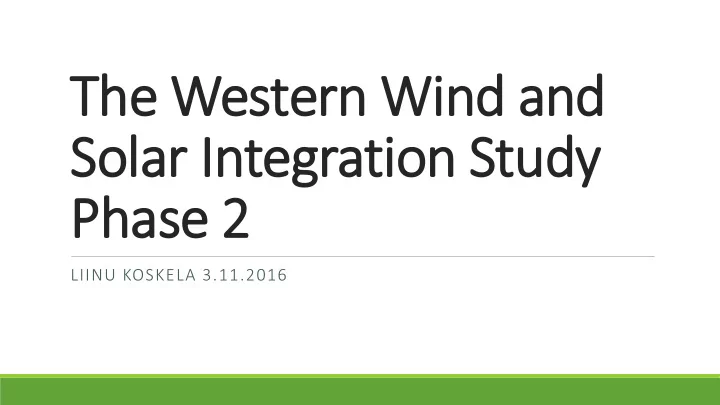

The Western Wind and Solar Integration Study Phase 2 LIINU KOSKELA 3.11.2016
Contents Introduction and background Research questions and the aim of the study Practices ◦ Input ◦ Assumptions ◦ Simulation Results Conclusions
Introduction and background
Introduction and background Western Wind and Solar Intergration Study (WWSIS) Study Phase 2 Conducted by NREL, US, 2013 Authors: ◦ D. Lew, G. Brinkman, E. Ibanez, A. Florita, M. Heaney, B.-M. Hodge, M. Hummon, G. Stark, J. King, S.A. Lefton, N. Kumar, D. Agan, G. Jordan and S. Venkataraman
Introduction and background Cycling Impacts of cycling ◦ Costs ◦ Emissions
Introduction and background: Study questions What are the increased costs because of wear and tear on fossil-fueled plant? Do these wear-and-tear costs significantly reduce the benefits of wind and solar? Will incorporating these costs into optimization of grid operation reduce cycling? What are the emissions impacts of cycling? How do wind impacts compare to solar impacts on cycling and grid operation?
Practices
Practices
Wind (and solar) Input Typical wind plant output for 2004 to 2006 with some corrections WWSIS-2 used a DA (day ahead) and 4HA (4 hours ahead) forecasts and a real-time dispatch every 5 minutes Solar power output was modeled with Hummons’s & co. algorithm Solar forecasts were same as in WWSIS-1
System input The amount of conventional generators were same in all cases The fossile fuel plants were divided into seven cases: ◦ Coal ◦ Small, subcritical steam (35 MW – 299 MW) ◦ Large, subcritical steam (300 MW – 900 MW) ◦ Large, supercritical steam (500 MW – 1,300 MW) ◦ Gas ◦ Combined cycle (CC) — combustion turbine (CT)/steam turbine (ST), heat recovery steam generator (HRSG) ◦ Simple-cycle, large-frame CT ◦ Simple-cycle, aero-derivative CT ◦ Steam (50 MW – 700 MW)
Scenarios 1. No Renewables — 0% wind, 0% solar 2. TEPPC — 9.4% wind, 3.6% solar (the base case) 3. High Wind — 25% wind, 8% solar 4. High Solar — 25% solar, 8% wind 5. High Mix — 16.5% wind, 16.5% solar
Scenarios
Scenarios - Assumptions Each zone meets their own flexibility Real-time start for CT and internal combustion Gas price $4,60/MMBtu No new connections to Mexico or Canada
Simulations
Simulations
Simulations
Simulations
Results
Production
Production
Displaced generation
Costs
Emissions
Conclusions Renewables increased cycling costs but decreased production costs More ramping in coal generators in high wind scenario Emission savings: CO2: 29-34%, NOx: 16-22%, SO2: 14-24%, cycling effect is small
Evaluation Transmission scenarios to Mexico and Canada were not included Rarely examined subject One year wind data No dynamic studies A few different economic cases Does not take into account the installation costs Models ◦ Two forecasts and real time dispatch every 5 minutes ◦ Optimized security
Recommend
More recommend